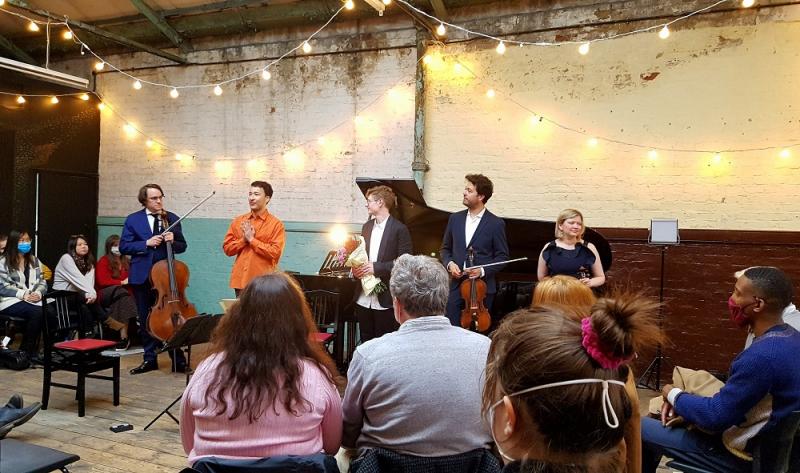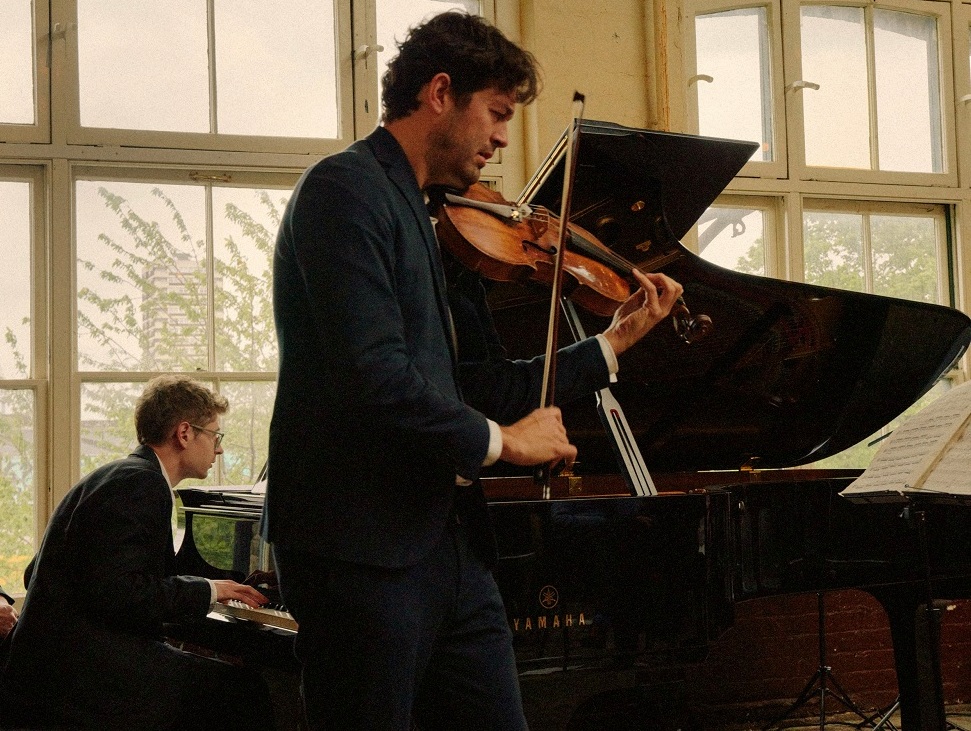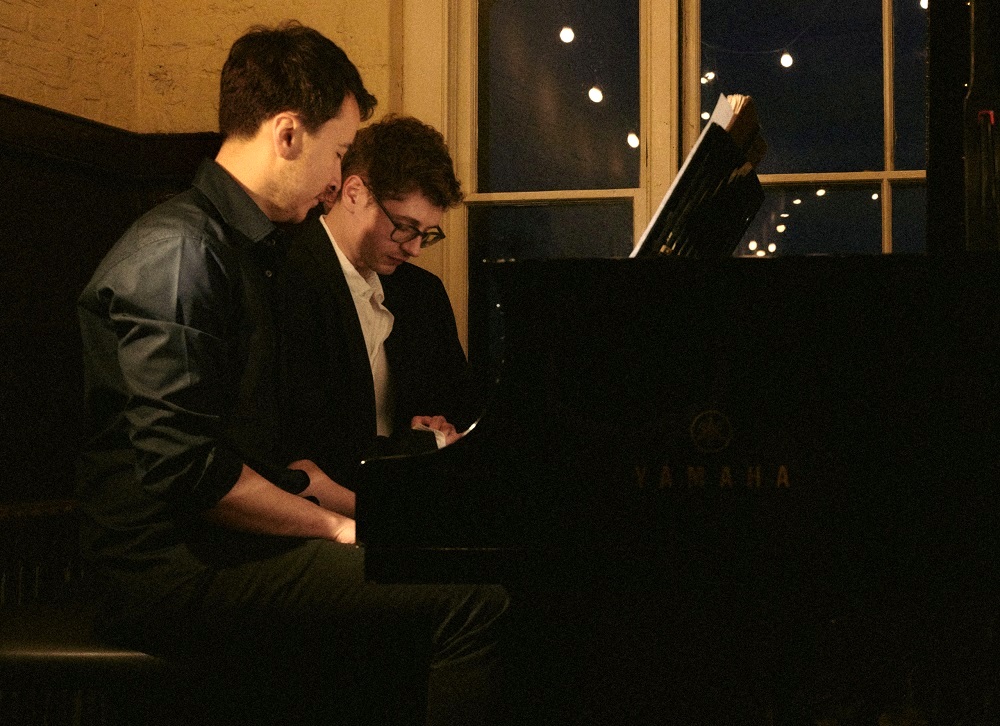Ragged Music Festival 2021, Ragged School Museum review - harrowing of hell from great musicians | reviews, news & interviews
Ragged Music Festival 2021, Ragged School Museum review - harrowing of hell from great musicians
Ragged Music Festival 2021, Ragged School Museum review - harrowing of hell from great musicians
Pavel Kolesnikov and Samson Tsoy welcome colleagues for a mind-blowing weekend

Seven months might just about be enough time to have digested the deep and intense offerings of the Second Ragged Music Festival before moving on to more soul-shattering and transcendence in the third.
Back in the top-floor schoolroom with its haunting air of decay on another rainy,windy evening like the ones back in October. Britten’s Lachrymae served as a spectral starting-point, with an odd sigh from the building at one point echoing the dark resonance of Lawrence Power’s viola. Britten’s variations work backwards from fragmentation to a full, simple statement of Dowland’s “If my complaints could passion move" (there’s also a quotation from “Flow, my tears” in the fifth variation). I’ve never before heard them prefaced by the main song, unaccompanied, but it makes perfect sense, especially at the start of a festival. With Kolesnikov’s entry (the performance pictured below), a disturbing game of ghost cat and mouse ensued in razor-sharp partnership, rising to frenzy before the release of the full quotation.  The same thing happens at a similar point in Messiaen’s Thème et Variations for violin and piano, a late addition on Alina Ibragimova’s part, this time unleashing a magnesium flare of sound. She and Tsoy had given a more sustained lead-up to an even more blinding radiance in the final movement of the Quartet for the End of Time, which they played in their first recital together at the Fidelio Orchestra Café, before performing the whole work at the Second Ragged Music Festival with clarinettist Nicolas Baldeyrou and cellist Andrei Ioniță. One significant meeting in this case has led to a festival friendship without which the far-from-ragged music-making in both years would not have been quite as miraculous..
The same thing happens at a similar point in Messiaen’s Thème et Variations for violin and piano, a late addition on Alina Ibragimova’s part, this time unleashing a magnesium flare of sound. She and Tsoy had given a more sustained lead-up to an even more blinding radiance in the final movement of the Quartet for the End of Time, which they played in their first recital together at the Fidelio Orchestra Café, before performing the whole work at the Second Ragged Music Festival with clarinettist Nicolas Baldeyrou and cellist Andrei Ioniță. One significant meeting in this case has led to a festival friendship without which the far-from-ragged music-making in both years would not have been quite as miraculous..
Between the two sets of variations, Tsoy gave us a full-blooded, utterly engaging account of Bach’s Second Keyboard Partita, in the same C minor as the Britten. After the Messiaen, we were ripped apart again in Beethoven’s Grosse Fuge. Imagine the impact not only from players – the wonderful Doric Quartet – who can give it their all without having to play anything else in a programme, but also on an audience at very close quarters. It was like being in the eye of the storm, though calm is to be found there, and not here, where the electrotherapy was felt at every magnificent blow.
Last year there was little relief from the dark and towering. In the 9pm concert, we were allowed to smile and untense as Ibragimova and Tsoy flowed their way through polar-opposite Beethoven, the “Spring” Sonata, delivered as if it were one inspired improvisation, every transition perfectly gauged. That was true, too, of this four-hand piano performance of Stravinsky’s The Rite of Spring: not entirely the one which the composer gave with Debussy (imagine!) in 1913. Surely those surprisingly graceful wrappings of Tsoy’s arms around Kolesnikov to get to the lower depths of the piano weren’t the norm? I asked him later, and it turned out they wanted to conjure more of the percussion sounds in the score, so this was Stravinsky-plus. (Pictured below: Tsoy and Kolesnikov preparing for the performance). All present could safely say they’d never heard more on a single piano, from delicate freedom in treble songs to thunderous bass, all of it without bashing, a constant watchful poise keeping things just under control, culminating in a fast, well-sprung approach to the main rhythm-changes of the Sacrificial Dance. For all that, thank not only these players’ incredible, Russian-trained technique but also the glorious Yamaha, winched up to the top floor as before and constantly supervised by the modest but brilliant piano technician Kazuhiko Ohmaru.
All present could safely say they’d never heard more on a single piano, from delicate freedom in treble songs to thunderous bass, all of it without bashing, a constant watchful poise keeping things just under control, culminating in a fast, well-sprung approach to the main rhythm-changes of the Sacrificial Dance. For all that, thank not only these players’ incredible, Russian-trained technique but also the glorious Yamaha, winched up to the top floor as before and constantly supervised by the modest but brilliant piano technician Kazuhiko Ohmaru.
For the second evening, the concert layout had been shifted 90 degrees. We could no longer look beyond the players to the skies beyond, where seagulls had performed a slightly counterintuitive ballet to the start of the Grosse Fuge. Both ways, acoustics remained oddly perfect (thank the wooden floors and the height of the big skylight), but somehow a semicircle of listeners with the musicians central worked better. The first concert was a harrowing, a catharsis, very much fixated on death. Shostakovich’s Viola Sonata turned out to be his swansong, taking us through the process of dying in the long final movement. But it also re-uses music from the unfinished Gogol opera The Gamblers for its scherzo, turned into another of those klezmerish dances over a grave.
No wonder Power broke a string here – a better place to do it than the outer movements (quickly fixing it, he came back on to start the dancing again). Kolesnikov’s terrifying bass came into full force when the finale has what could only be imagined as a massive stroke, after which the music slowly dies to fragments of Beethoven’s “Moonlight” Sonata. Brahms’s Horn Trio in its version with viola started a healing, with Ibragimova and Power duetting so soulfully against Tsoy’s secure support (pictured below by Lea Thijs: Ibragimova, Tsoy and Power), but here, too, naked grief intrudes in the slow movement, composed following the death of Brahms's mother.  The contrasts were extreme and powerful from our trio, but where to start with the range of Kolesnikov in his already-celebrated but presumably never-the-same-twice Bach Goldberg Variations? Peter Quantrill, reviewing the Wigmore Hall performance, highlighted the translation of harpsichord technique to the piano and the French accent. But while there’s never a wrench from one sonority to another, Kolesnikov surely runs the gamut. Many listeners know what sort of Goldbergs they want to hear, and some pianists oblige in their take on it, but this interpretation will be congruent with everyone’s hopes at some point, and shatter any complacency.
The contrasts were extreme and powerful from our trio, but where to start with the range of Kolesnikov in his already-celebrated but presumably never-the-same-twice Bach Goldberg Variations? Peter Quantrill, reviewing the Wigmore Hall performance, highlighted the translation of harpsichord technique to the piano and the French accent. But while there’s never a wrench from one sonority to another, Kolesnikov surely runs the gamut. Many listeners know what sort of Goldbergs they want to hear, and some pianists oblige in their take on it, but this interpretation will be congruent with everyone’s hopes at some point, and shatter any complacency.
Wistfully elegant, wildly witty and playful, river-rippling, achingly, time-takingly sad (in Variation 25), cannonading to the sound of a full church congregation before returning, but transformed, to the starting point, it’s a universe, as it should be, And the next time we hear Kolesnikov play them, the Goldbergs will sound different again. May it be in his feted partnership with Anna Teresa De Keersmaeker, whose previous work with Jean-Guihen Queyras on the Cello Suites was the finest matching of dance to great music I’ve ever witnessed.
Sunday evening promised, in the words of the programme sheet, a “grand finale” and an “epilogue”. For various reasons, I could only stay for the official festival finale, bringing together the two pianists and two regular string soloists with John Myerscough of the Dorics. Schumann’s Piano Quartet, robust and occasionally heaven-storming here, pales only alongside his Piano Quintet – that has a truly profound slow movement, while the theme of the Andante cantabile here always feels a bit glib to me, even though Myerscough especially kept excess sentimentality at bay.  By the same token, Brahms’s First Piano Quartet doesn’t go quite as deep or wide as his second, the magnificent A major; but the G minor work is a rightly celebrated giant. If the unisons of Ibragimova (pictured above with Tsoy on the Friday evening) and Power were almost overpowering in the big first movement, there was a fabulous and precise scaling-down for the mostly-muted Intermezzo.
By the same token, Brahms’s First Piano Quartet doesn’t go quite as deep or wide as his second, the magnificent A major; but the G minor work is a rightly celebrated giant. If the unisons of Ibragimova (pictured above with Tsoy on the Friday evening) and Power were almost overpowering in the big first movement, there was a fabulous and precise scaling-down for the mostly-muted Intermezzo.
The fireworks of Brahms’s second half turned out to be explosives: Kolesnikov set off a bomb under the military march which swaggers into the noble world of the Andante con moto, for all the world here llike one of Shostakovich's ironic intrusions, and the Rondo alla Zingarese wasn’t so much wacky cod-Roma-ishness as demonic: a dazzling finale, but a scary one. The promised epilogue, another epic, was Schubert’s Winterreise with Kolesnikov partnering Mark Padmore. A distinguished colleague who did stay remarked that he ‘"enjoyed Padmore's intense, dramatic way with the songs, and thought Kolesnikov’s accompaniment was stunning": that makes me all the more regretful that I couldn’t be completist about this year’s festival.
rating
Explore topics
Share this article
The future of Arts Journalism
You can stop theartsdesk.com closing!
We urgently need financing to survive. Our fundraising drive has thus far raised £49,000 but we need to reach £100,000 or we will be forced to close. Please contribute here: https://gofund.me/c3f6033d
And if you can forward this information to anyone who might assist, we’d be grateful.

Subscribe to theartsdesk.com
Thank you for continuing to read our work on theartsdesk.com. For unlimited access to every article in its entirety, including our archive of more than 15,000 pieces, we're asking for £5 per month or £40 per year. We feel it's a very good deal, and hope you do too.
To take a subscription now simply click here.
And if you're looking for that extra gift for a friend or family member, why not treat them to a theartsdesk.com gift subscription?
more Classical music
 Echo Vocal Ensemble, Latto, Union Chapel review - eclectic choral programme garlanded with dance
Beautiful singing at the heart of an imaginative and stylistically varied concert
Echo Vocal Ensemble, Latto, Union Chapel review - eclectic choral programme garlanded with dance
Beautiful singing at the heart of an imaginative and stylistically varied concert
 Scott, Irish Baroque Orchestra, Whelan, RIAM, Dublin review - towards a Mozart masterpiece
Characteristic joy and enlightenment from this team, but a valveless horn brings problems
Scott, Irish Baroque Orchestra, Whelan, RIAM, Dublin review - towards a Mozart masterpiece
Characteristic joy and enlightenment from this team, but a valveless horn brings problems
 Classical CDs: Voice flutes, flugelhorns and froth
Baroque sonatas, English orchestral music and an emotionally-charged vocal recital
Classical CDs: Voice flutes, flugelhorns and froth
Baroque sonatas, English orchestral music and an emotionally-charged vocal recital
 Kanneh-Mason, Britten Sinfonia, Shave, Milton Court - a grin and a big beaming smile
A pair of striking contemporary pieces alongside two old favourites
Kanneh-Mason, Britten Sinfonia, Shave, Milton Court - a grin and a big beaming smile
A pair of striking contemporary pieces alongside two old favourites
 theartsdesk at the New Ross Piano Festival - Finghin Collins’ musical rainbow
From revelatory Bach played with astounding maturity by a 22 year old to four-hand jazz
theartsdesk at the New Ross Piano Festival - Finghin Collins’ musical rainbow
From revelatory Bach played with astounding maturity by a 22 year old to four-hand jazz
 First Person: Manchester Camerata's Head of Artistic Planning Clara Marshall Cawley on questioning the status quo
Five days of free events with all sorts of audiences around Manchester starts tomorrow
First Person: Manchester Camerata's Head of Artistic Planning Clara Marshall Cawley on questioning the status quo
Five days of free events with all sorts of audiences around Manchester starts tomorrow
 Goldscheider, Brother Tree Sound, Kings Place review - music of hope from a young composer
Unusual combination of horn, strings and electronics makes for some intriguing listening
Goldscheider, Brother Tree Sound, Kings Place review - music of hope from a young composer
Unusual combination of horn, strings and electronics makes for some intriguing listening
 theartsdesk Q&A: composer Donghoon Shin on his new concerto for pianist Seong-Jin Cho
Classical music makes its debut at London's K-Music Festival
theartsdesk Q&A: composer Donghoon Shin on his new concerto for pianist Seong-Jin Cho
Classical music makes its debut at London's K-Music Festival
 Helleur-Simcock, Hallé, Wong, Bridgewater Hall, Manchester review - moving lyricism in Elgar’s concerto
Season opener brings lyrical beauty, crisp confidence and a proper Romantic wallow
Helleur-Simcock, Hallé, Wong, Bridgewater Hall, Manchester review - moving lyricism in Elgar’s concerto
Season opener brings lyrical beauty, crisp confidence and a proper Romantic wallow
 Kohout, Spence, Braun, Manchester Camerata, Huth, RNCM, Manchester review - joy, insight, imagination and unanimity
Celebration of the past with stars of the future at the Royal Northern College
Kohout, Spence, Braun, Manchester Camerata, Huth, RNCM, Manchester review - joy, insight, imagination and unanimity
Celebration of the past with stars of the future at the Royal Northern College

Add comment